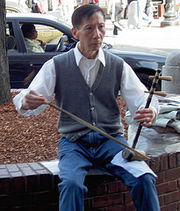| Home | Etymology | History | Performers | Visual | Aural | Repertoire | Film | Opera Houses | |||||
 |
|||||
 |
 The jinghu, an instrument commonly used in Beijing opera music [link to wiki] The jinghu, an instrument commonly used in Beijing opera music [link to wiki]Vocal production in Beijing opera is conceived of as being composed of "four levels of song": songs with music, verse recitation, prose dialogue, and non-verbal vocalizations. The conception of a sliding scale of vocalization creates a sense of smooth continuity between songs and speech. The three basic categories of vocal production technique are the use of breath (yongqi), pronunciation (fayin), and special Beijing opera pronunciation (shangkouzi). In Chinese opera, breath is based in the pubic region and supported by the abdominal muscles. Performers follow the basic principle that "Strong centralized breath moves the melodic-passages" (zhong qi xing xiang). Breath is visualized being drawn up through a central breathing cavity extending from the pubioc region to the top of the head. This "cavity" must be under the performer's control at all times, and he or she develops special techniques to control both entering and exiting air. The two major methods of taking in breath are known as "exchanging breath" (huan qi) and "stealing breath" (tou qi). "Exchanging breath" is a slow, unhurried process of breathing out old air and taking in new. It is used at moments when the performer is not under time constraint, such as during a purely instrumental musical passage or when another character is speaking. "Stealing breath" is a sharp intake of air without prior exhalation, and is used during long passages of prose or song when a pause would be undesirable. Both techniques should be invisible to the audience and take in only the precise amount of air required for the intended vocalization. The most important principle in exhalation is "saving the breath" (cun qi). Breath should not be expended all at once at the beginning of a spoken or sung passage, but rather expelled slowly and evenly over its length. Most songs and some prose contain precise written intervals for when breath should be "exchanged" or "stolen". These intervals are often marked by carats. Pronunciation is conceptualized as shaping the throat and mouth into the shape necessary to produce the desired vowel sound, and clearly articulating the initial consonant. There are four basic shapes for the throat and mouth, corresponding to four vowel types, and five methods of articulating consonants, one for each type of consonant. The four throat and mouth shapes are "opened-mouth" (kaikou), "level-teeth" (qichi), "closed-mouth" (hekou or huokou), and "scooped-lips" (cuochun). The five consonant types are denoted by the portion of the mouth most critical to each type's production: throat, or larynx (hou); tongue (she); molars, or the jaws and palate (chi); front teeth (ya); and lips (chun). Some syllables (written Chinese characters) have special pronunciations in Beijing opera. This is due to the collaboration with regional forms and kunqu that occurred during the development of Beijing opera. For example, 你, meaning "you", may be pronounced li, as it is in the Anhui dialect, rather than the Standard Mandarin ni. 我, meaning "I" and pronounced wo in Standard Mandarin, becomes ngo, as it is pronounced in the dialect of Suzhou. In addition to pronunciation differences that are due to the influence of regional forms, the readings of some characters have been changed to promote ease of performance or vocal variety. For example, zhi, chi, she, and ri sounds do not carry well and are difficult to sustain, because they are produced far back in the mouth. Therefore, they are performed with an additional i sound, as in zhii. These techniques and conventions of vocal production are used to create the two main categories of vocalizations in Beijing opera: stage speech and song. |
||||
 |
|||||
 |
|||||
| Copyright RUIWEI Credit Page | |||||